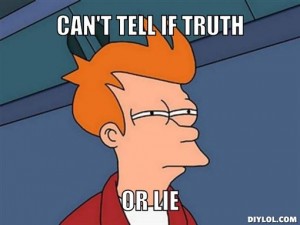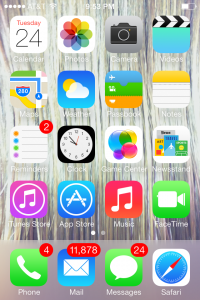Being invited to give an opening keynote is both incredibly flattering and intimidating. Addressing the KDE community at their Akademy is even more intimidating: I want to be light, funny, deep, serious, relevant, insightful and create a base for discussion. No wonder I couldn’t stop editing my slides until long after sundown.

Tweet: doubly useless
The goal of my talk was to address the problem of the increased TiVo-ization of life, democracy and policy. Stated simply TiVo-ization is following the letter of rules/principles while subverting them by changing what is physically possible (wikipedia on origins and deeper meaning)
In order to set the stage I presented earlier communications revolutions. Reading and writing are 6000 years old, but punctuation took almost 4000 years to develop and empty spaces between words are only 1000 years old. What we see here is that communication is a code that evolves, it gets hacked and improved. Despite its accessibility it retains several bugs for millennia.
The invention of writing is a paradigm shift. But its taken for granted. printing on the other hand is seen as an amazing shift. In my view Gutenberg was the Steve Jobs of his day, Gutenberg built on the earlier major shifts and worked on packaging – he gets much more credit for revolution than he deserves.

Tweet: Gutenberg
Communication evolves nicely (telegraphs, radio, television) but the really exciting and cool stuff occurs with digitalization. This major shift is today easily overlooked, together with the Internet, and we focus on the way in which communication is packaged rather than the infrastructure that makes it possible.
The WWW is one on these incredible packages that was created with an openness ideal. We should transmit whatever we liked as long as we followed the protocol for communication. So far so good. Our communications follow the Four Freedoms of Free Software, Communication is accessible, hackable and usable.

Tweet: Stallman
Unfortunately this total freedom inevitably creates the environment that invites convenience. Here corporations provide this convenience but at the cost of individual freedom and, in the long run, maybe at the cost of the WWW.
The risk to the WWW emerges from the paradox of our increasing use of the Web. Our increased use has brought with it a subtle shift in our linking habits. We are sending links to each other via social media on an unimaginable level. Sharing is the point of social media. The early discussion on blogging was all about user generated content. This is still important, but the focus of social media today is not on content generation but on sharing.
Focusing on sharing rather than content creation means we are creating less and linking less. Additionally the links we share are all stored in social media sites. These are impermanent and virtually unsearchable – they are virtually unhistoric. Without the links of the past there is no web “out in the wild” – the web of the future will exist only within the manicured and tamed versions within social network nature preserves (read more Will the web fail?)
On an individual level the sharing has created a performance lifestyle. This is the need to publicize elements of your life in order to enhance the quality of it. (Read more Performance Lifestyle & Coffee Sadism).

Tweet: coffee
This love of tech is built on the ideology that technology creates freedom, openness and democracy – in truth technology does not automatically do this. Give people technology and in all probability what will be created is more porn.
The problem is not that social media cannot be used for deeper things, but rather that the desire of the corporations controlling social media is to enable shallow sharing as opposed to deep interaction. Freedom without access to the code is useless. Without access to the code what we have is the TiVo-ization of everyday life. If you want a picture then this is a park bench that cannot be used by homeless people.

image from Yumiko Hayakawa essay Public Benches Turn ‘Anti-Homeless’ (also recommend Design with Intent)
Park benches which are specifically designed to prevent people from sleeping on benches. In order to exclude an undesirable group of people from a public area the democratic process must first define a group as undesirable and then obtain a consensus that this group is unwelcome. All this must be done while maintaining the air of democratic inclusion – it’s a tricky, almost impossible task. But by buying a bench which you cannot sleep on, you exclude those who need to sleep on park benches (the homeless) without even needing to enter into a democratic discussion.Only homeless people are affected. This is the TiVo-iztion of everyday life.
The more technology we embed into our lives the less freedom we have. The devices are dependent on our interaction as we are dependent upon them. All to often we adapt our lives to suit technology rather than the other way around.
In relation to social media the situation becomes worse when government money is spent trying to increase participation via social networks. The problem is that there is little or no discussion concerning the downsides or consequences of technologies on society . We no longer ask IF we should use laptops/tablets/social media in eduction but only HOW.
Partly this is due to the fear of exclusion. Democracy is all about inclusion, and pointing out that millions of users are “on” Facebook seems to be about inclusion. This is naturally a con. Being on/in social media is not democratic participation and will not democratize society. Why would you want to be Facebook friends with the tax authority. And how does this increase democracy?
The fear of lack of inclusion has led to schools teaching social media and devices instead of teaching Code and Consequences. By doing this, we are being sold the con that connection is democracy.

Tweet: Gadgets
So what can we do about it?
We need to hack society to protect openness. Not openness without real function (TiVo-ization) but openness that cannot be subverted. This is done by forcing social media to follow law and democratic principles. If they cannot be profitable within this scenario – tough.
This is done by being very, very annoying:
1. Tell people what the consequences of their information habits will have.
2. Always ask who controls the ways in which our gadgets affect our lives. Are they accountable?
3. Read ALL your EULA… Yes, I’m talking to you!
4. Always ask what your code will do to the lives of others. Always ask what your technology use will do to the lives of others…
The slides are here:
 The problem is that the convenience offered by our technology allows us to both know this and simultaneously believe that what appears on our screens is (mostly) true. It is easier for us to doubt the truth of images and facts we find online (because we have been fooled before) but we tend not to question the bias built into our systems.
The problem is that the convenience offered by our technology allows us to both know this and simultaneously believe that what appears on our screens is (mostly) true. It is easier for us to doubt the truth of images and facts we find online (because we have been fooled before) but we tend not to question the bias built into our systems.







